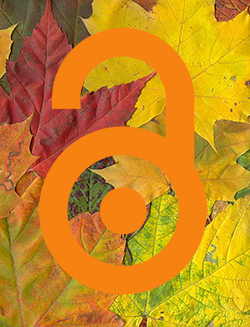
Fall Leaves photo by Micha L. Rieber, Licensed Creative Commons Attribution-Share Alike 3.0 Unported
Confused by the varieties of Open Access? “Green OA” and “Gold OA” are terms commonly used in scholarly publishing to denote levels of openness of academic journals. In the early years of the 21st century,several groups, projects, and meetings began the conversation about the availability of scholarly publications. From these discussions came founding documents such as the Budapest Open Access Initiative (2002) and the Bethesda Statement on Open Access Publishing (2003). The SHERPA: Securing a Hybrid Environment for Research Preservation and Access project at the University of Nottingham began using Green and Gold as codes for open access publishing models in its RoMEO database on publisher copyright and self-archiving policies.
The conversation continues to develop but, in essence, the color distinction is between:
- Green
Journal content is fee-based but the publisher offers authors the ability to self-archive a copy (either pre-print or post-print) of his or her paper in institutional repositories such as ScholarWorks. - Gold
Journal content is completely open access or open to all after a delay (embargo period). The open content is offered at the publisher’s website and does not need to be stored elsewhere to make it available as in the case of Green OA.
As publishers, authors, funders, and libraries negotiate this new landscape, many alternative or hybrid models of Open Access have also appeared. Hybrid models address who will pay the cost of publishing open access materials and place the cost burden on the author, on the institution, on the library, or a combination thereof by means of subscription credits or debits or direct author payments.
Open Access Tools
Curious about the open access journals in your field? These tools may help you sort out appropriate publication venues.
The SHERPA/RoMEO database, mentioned above, provides a searchable interface for publisher policies regarding self-archiving, included if post-prints are allowed or only pre-prints.
The Open Access Spectrum Evaluation Tool, created by SPARC and PLOS, provides a score for journals based on their degree of openess. Scores are based on the rubic from PLOS’ How Open is It? guide.
Beall’s List of Predatory Publishers, compiled annually by librarian Jeffrey Beall since 2011, is actually several different lists covering journals and publishers which mislead authors by charging high fees, providing inadequate review, or misreporting readership or other metrics.
The Web of Science database began denoting open access journals in search results some years ago and its sister database, Journal Citation Reports (JCR), now offers the ability to filter search results for open access titles. JCR, the home of the “Impact Factor,”tm provides information on citation rates of articles in selected journals and rankings of journal by discipline in the sciences and social sciences.
Completely Open Access Journals
The Directory of Open Access Journals (DOAJ) is the standard directory of fully open access journals with no embrago. Launched at Lund University in 2003, the DOAJ completed last year a complete review of all indexed titles to exclude suspect or predatory titles as well as those of dubious quality. DOAJ has filters for subject area based on Library of Congress headings.
Partial Open Access Titles from Publishers
The following collections in our catalog represent journals from publishers or organizations. While some titles may be fully open, other journals in these collections may have an embargo period before being freely available.
- Cambridge University Press:Open Access
- Nature Open Access
- Project Euclid Open Access Journals
- ScienceDirect Open Access Titles
- Springerlink Fully Open Access Journals
- Taylor & Francis Open Access
- Wiley-Blackwell Open Access Titles
For More Information
See the Libraries’ Open Access LibGuide for information for authors as well as more resources for finding open access books and journals.
